Int. J. Communications, Network and System Sciences, 2017, 10, 108-117
http://www.scirp.org/journal/ijcns
ISSN Online: 1913-3723
ISSN Print: 1913-3715
Radar-Communication Integration Based on
MSK-LFM Spread Spectrum Signal
Zheng Dou, Xiaokang Zhong, Wenxu Zhang
College of Information and Communication Engineering, Harbin Engineering University, Harbin, China
How to cite this paper: Dou, Z., Zhong,
X.K. and Zhang, W.X. (2017) Radar-Com-
munication Integration Based on MSK-LFM
Spread Spectrum Signal. Int. J. Communi-
cations, Network and System Sciences, 10,
108-117.
https://doi.org/10.4236/ijcns.2017.108B012
Received: May 17, 2017
Accepted: August 11, 2017
Published: August 14, 2017
Abstract
At present, with the progress and innovation of technology, the radar com-
munication dual function wave has become a hot research at home and
abroad. Excellent integrated waveform can make full use resources of combat
platform, reduce the size of equipment, and realize the actual functionality of
the reality of the battle-field without affecting the radar communication func-
tion. The MSK-LFM dual-function wave is a typical representative; it is based
on LFM, through the MSK modulation to achieve the integration function.
This paper proposes a scheme of combining the spread spectrum technology
with the MSK-LFM waveform based on the previous literature. The simula-
tion results show that the waveform envelope is more stable and the energy is
more concentrated. With the introduction of spread-spectrum technology, the
new waveform ambiguity function graph is much closer to the thumbtack
than the traditional MSK-LFM waveform.
Keywords
Radar-Communication Integration, Direct Sequence Spread Spectrum,
Ambiguity Function, MSK-LFM
1. Introduction
With the development of science and technology and the complexity of the bat-
tlefield environment, the equipment systems of military field demand more and
more. Combat platform had to be equipped more electronic equipment to meet
the overall needs of the battlefield, such as: communications, radar, interference
and so on. These devices integrated the combat platform, not only increases vo-
lume and energy consumption of the equipment system, but bring the interfe-
rence between the various systems, it reduce the performance and efficiency of
the entire platform, so the mobility was reduced, and the problem of conceal-
ment was ensued. Therefore, the integration of the combat system is imminent,
DOI: 10.4236/ijcns.2017.108B012 August 14, 2017
�
Z. Dou et al.
It’s important to replacing simple linear superposition by combining different
types of electronic devices with different functions. Integrated combat platform,
can not only conducive to real-time coordination of the work of the system, but
also contribute to the deployment of resources and the platform integration,
improve reliability and portability of the equipment system.
In the literature [1], Chen Xingbo proposed a scheme that uses the LFM as the
MSK carrier to form a new MSK-LFM signal. It both had radar detection func-
tion and communication function, then he analyzed it from the theory. The
spread spectrum technology is applied to the radar signal, which can remarkably
improve the performance of the signal ambiguity function. By comparing the
LFM and the integrated waveform with the same conditions, we can see the per-
formance of the wave-form after the spread spectrum is similar to the previous
two, and it demonstrate the practicability of the new waveform.
2. Radar Communication Integrated Waveform Design
Based on MSK-LFM Signal
2.1. MSK-LFM Integrated Communication Radar Waveform
Signal Generated
Refer to the literature [2] [3], the kth symbol of the MSK signal can be expressed as:
s
k
MSK
t
( )
=
cos(2
π
f t
c
+
a t
π
k
T
2
+
ϕ
k
)
(1)
In this formula,
ka = ± ,
1
kϕ is the initial phase determined by the kth sym-
bol.
Reference to MSK modulation with a single carrier , the integrated waveform
, then the kth bit modulation symbol
tµ+
cf to
cf
2
changes the carrier from
of the integrated waveform is:
t
s ( )
k
=
cos(2
t
π µπ
f t
c
+
2
+
a t
π
k
T
2
+
ϕ
k
)
(2)
After the corresponding triangular transformation, Equation (2) can be ex-
pressed as an orthogonal form:
s t
( )
k
=
p
k
cos(
t
π πµ
f t
c
+
2
)
(3)
)cos(2
t
π
T
2
t
π
)sin(2
T
2
−
q
k
sin(
t
π πµ
f t
c
+
2
)
It can be seen from the formula (1) (2) that the MSK-LFM signal and the MSK
signal are different from the carrier, the baseband signal is the same, so we can
conclude that and have the same properties of MSK. According to Equation (3)
we can get the schematic diagram of the integrated waveform generation shown
in Figure 1.
Refer to the he literature [4], if the phase of the signal is continuous, then the
spectrum of the signal is narrow, the sidelobe descends faster, it also reduces the
adjacent channel interference, and improves the bandwidth efficiency.
Through simulation can be drawn, the data and the time domain simulation
109
�
Z. Dou et al.
Figure 1. MSK-LFM flow diagram.
110
of the integrated waveform are shown below.
From Figure 2 and Figure 3, we can see, the waveform frequency slightly
changed, the waveform become more and more dense, it meet the LFM wave-
form features. Because it uses MSK modulation, so the overall waveform phase is
continuous.
2.2. Spectrum Analysis of MSK-LFM Radar Communication
Integrated Waveform
When making integration waveform modulation, radar waveform is using LFM
signal, communication waveform is MSK, the important reason is that MSK
signal is advantage in bit error rate and power spectrum. At the same time, this
waveform has less spectrum expansion and more concentrated spectrum. The
signal spectrum is shown below.
According to Figures 4-6, the spectrum of the integrated waveform should be
between 20 MHz and 25 MHz, and the energy outside should be close to zero,
the result is same as the spectrum of the chirp signal what was given in the
simulation results, therefore, there is a good radar detection performance.
3. Radar Communication Integrated Waveform Design
Based on the Spread-Spectrum MSK-LFM Signal
3.1. Spread Spectrum Technology Application
Spread spectrum is spread original signal spectrum through some kind of
modulation. The commonly used three types of spread-frequency technology
are respectively: 1) Direct sequence spread spectrum, that is, represents a
symbol with a pseudo code, and then the carrier is modulated. Because the
chip rate is higher than the symbol rate, the spectrum of the modulated signal
is extended; 2) Frequency hop-ping spread spectrum, that is, carrier frequen-
cy hopping in a symbol time, so achieve the purpose of spread spectrum; 3)
�
Figure 2. Raw data.
Figure 3. Integrated modulation waveform.
Figure 4. Spectrum after data modulation.
Z. Dou et al.
Figure 5. Spectrum after Full 1 data modulation.
Linear frequency modulation spread spectrum, that is, the carrier frequency varies
linearly in one symbol, and it achieves the purpose of spread spectrum. Because
111
�
Z. Dou et al.
Figure 6. Standard LFM spectrogram.
using a shorter pulse width or more wide pulse bandwidth, the bandwidth of the
signal after the spread spectrum becomes larger, and the narrowband interfe-
rence bandwidth is relatively small, so the spread spectrum communication
narrowband interference enhancement, while the spread spectrum communica-
tion also has Anti-eavesdropping, anti-multipath ability, can achieve the advan-
tages of code division multiple access.
As it can be seen from the above analysis, if we use spread spectrum technol-
ogy to achieve integrated waveform, it should have the same advantages and
spread spectrum communication. And whether the pseudo-code sequence of di-
rect sequence spread spectrum, or the chirp pulse of LFM spread, both has a
certain distance measurement capability of speed. So, we can use spread spec-
trum technology to design integrated waveform.
In the literature [5], direct sequence spread spectrum (DSSS) is to use a set of
spread spectrum codes to represent the information symbols, and then spread
the spectrum to modulate the carrier wave. Theoretically, the ideal spreading
code is a purely random sequence, but in the receiver, despreading requires a
copy of the spread spectrum code that is the same as the spread spectrum code
in transmitter. Some properties of PN sequence is similar to random noise, but
unlike random noise sequences what cannot reproduce, the PN sequence is rela-
tively easy to produce repeatedly and is easy to process, so it is beneficial to de-
spreading and recovering symbol information.
In the literature [6], the communication data is spread by the spreading code
to produce a digital baseband signal, then using the MSK-LFM way to digital
modulation, the resulting signal have improved in the spectrum analysis and
performance.
The pseudo-random sequence used as a spreading code can be expressed as:
c t
( )
=
L
1
−
∑
i
=
0
c g t
(
i
−
iT
c
)
(4)
In the formula, L represents the sequence length of the PN code, represents
the symbol period of the PN code; represents the i-th symbol of the PN code, the
value is {1, −1}.
Since the direct sequence spread spectrum is represented by a set of spreading
codes to represent a symbol information, the symbol period of the PN code is
112
�
smaller than the symbol period of the information. Then, in the literature [7],
the sequence after the direct sequence spread spectrum can be expressed as:
Z. Dou et al.
d t m t c t
( )
( ) ( )
=
=
1
−
l g t
(
i
−
iT
c
)
(5)
L
symN
∑
i
=
0
The
il is the ith symbol of the sequence after the direct spreading sequence,
and the value is {−1, 1}.
Add the spread spectrum module on the original basis, the input data per unit
time is increased, so the flow chart and the time domain sequence waveform are
shown in Figure 7.
Compared with the pre-spread waveform in Figure 8 and Figure 9, we can
see that the time-domain waveform is more closely.
3.2. Spectrum Analysis of the Integration of the Waveform
after Spread Spectrum
The frequency spectrum of the waveform after the spread spectrum can be ob-
Figure 7. The flow chart of the integrated waveform.
Figure 8. Information symbols and sequences after spreading.
113
�
Z. Dou et al.
Figure 9. Integration of modulation waveform after the spread spectrum.
Figure 10. The spectrum after spreading.
Figure 11. The spectrum of all 1 data.
Figure 12. Standard LFM spectrogram.
114
�
Z. Dou et al.
tained as follows, in Figures 10-12, it can be found, the bandwidth has been ex-
panded. We set the raw data to all 1 columns, the spectrum becomes approx-
imately the same as the standard linear FM signal, and it ensures that the radar
function can be achieved normally.
4. Performance Comparison of Ambiguity Function
Ambiguity function is one of the important indexes to measure radar waveform.
It is usually used as a tool to study the performance of different waveforms. The
ambiguity function of radar is defined as the model of two-dimensional cross
correlation function of radar signal, which represents the result of matched filter
output. The exact expression is:
∫
(6)
j
)exp( 2
s t s t
(
( )
f t dt
d
)
( ,
χτ
π
τ
=
+
+∞
)
−∞
f
d
*
The ambiguity function of MSK-LFM is given in document [8] [9], as shown
below:
( ,
χτ
f
d
)
=
( ,
χτ
f
d
)
=
1
−
N
∑
i
=
0
rect
{
iT
−
τ
(
T
) [
⋅
N i
−
∑
l
1
=
0
NTτ≤ ≤
f
l
(
+
i l t dt
, , )
+
(
l
+
i T
)
∫
l
( 1)
−
T
+
τ
N i
1
− −
∑
l
1
=
lT
+
τ
∫
(
l
+
i T
)
−
N
∑
i
1
=−
rect
{
iT
τ
−
(
T
) [
⋅
N
∑
i
1
= −
l
(
l
+
∫
l
( 1)
−
T
+
τ
−
i T
)
NT τ
≤ ≤
0
f
l
(
+
i l t dt
, , )
+
N
∑
=−
i
l
lT
τ
+
∫
(
l
+
i T
)
f
l
(
+ +
i
l l t dt
, , )
]}
(7)
f
l
(
+ +
i
l l t dt
, , )
]}
(8)
In the formula,
f k l t
( , , )
=
exp[
+
j
2 (
π
j
(
π
p q
l
1
T
2
p q
−
k
k
T
4
p
l
+
τ
p q
l
l
+
p
k
−
2
+
µτ
−
2
µτ
)
f
d
t
) ]
(9)
The literature [10] [11] give a ambiguity function three-dimensional diagram
of the integrated waveform. As we can see from the diagram, the ambiguity
function graph before the spread spectrum takes the shape of a pin shape, which
is different from the “edge type” of the standard LFM ambiguity function dia-
gram, this is the result of data modulation, and if the data becomes fully 1 or 0,
the MSK-LFM degenerates into a normal LFM signal.
The essence of spread spectrum, in fact, is to replace the original data with the
spread spectrum sequence in unit time, more data is modulated in per unit time,
the resulting ambiguity function 3D graph is sharper. By comparing the zero de-
lay slice and the zero Doppler slice before and after spread spectrum, it is found
that there is almost no change in velocity resolution; In the zero delay slice, the
width of the main lobe is narrowed, sidelobe is suppressed, and the range resolu-
tion is better.
5. Conclusions
MSK-LFM is a new type of radar communication dual function waveform.
When the communication data is spread out and modulated again, the bandwidth
115
�
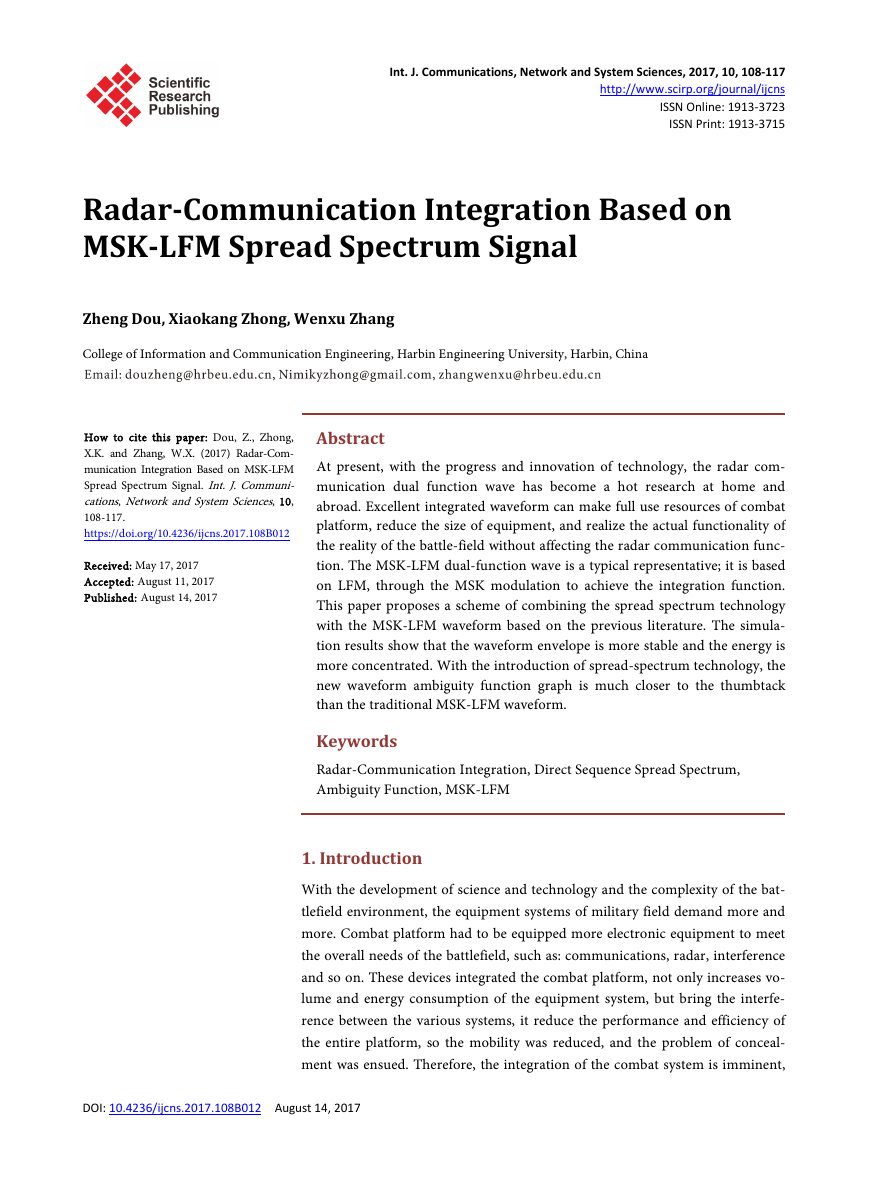
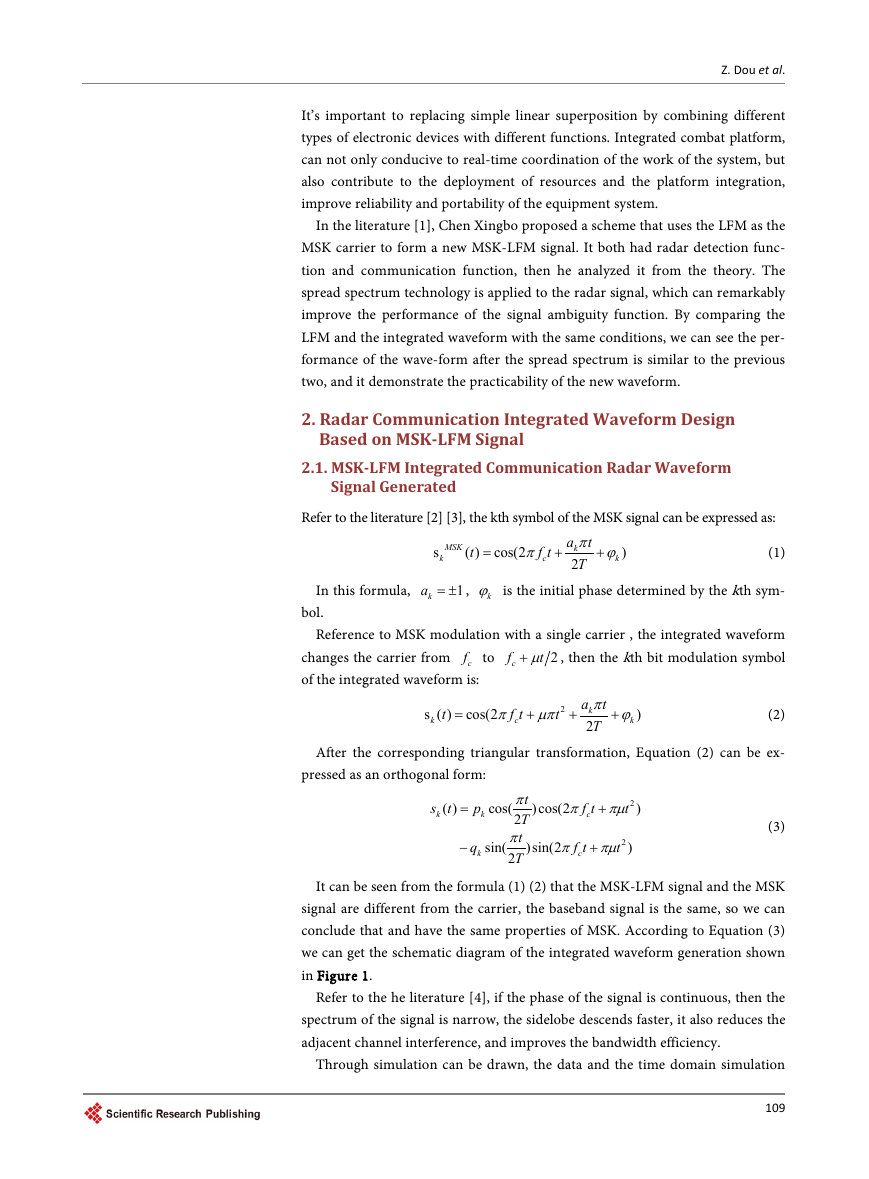

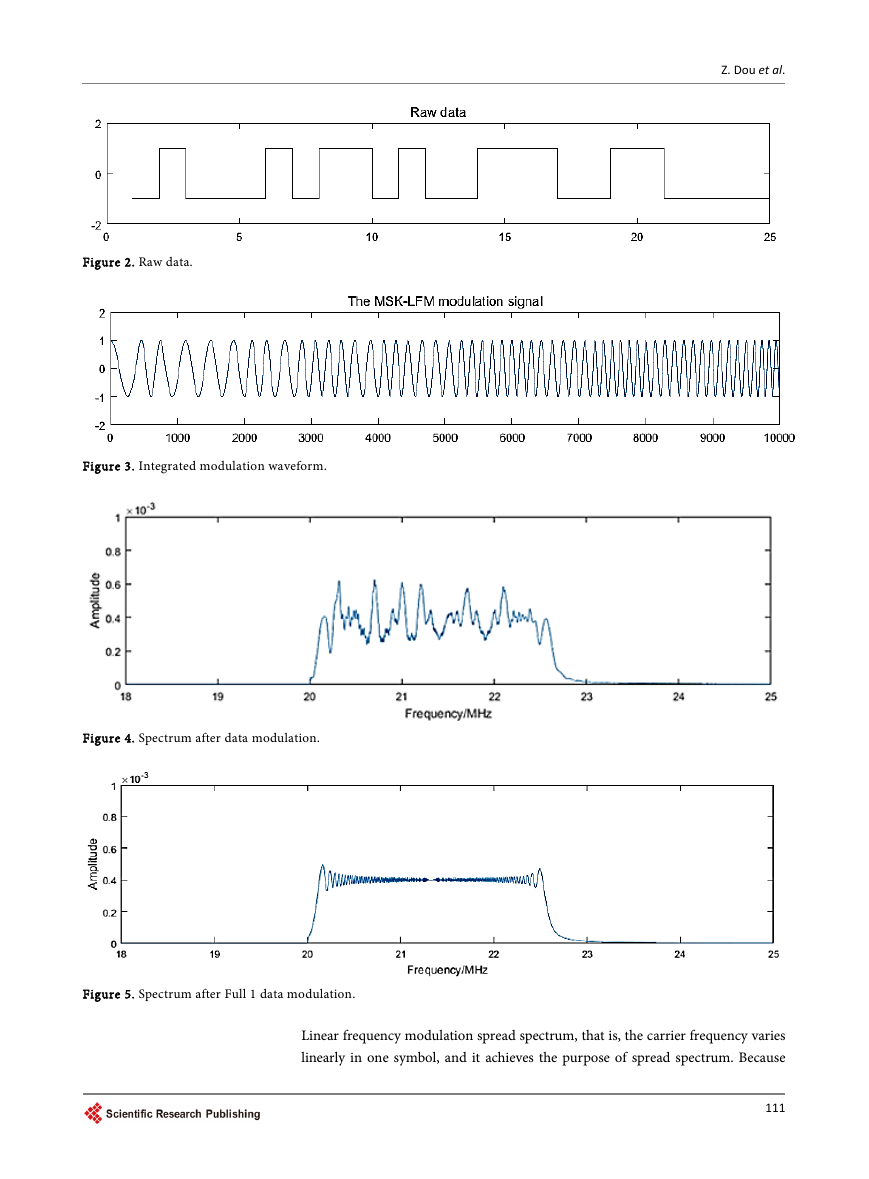
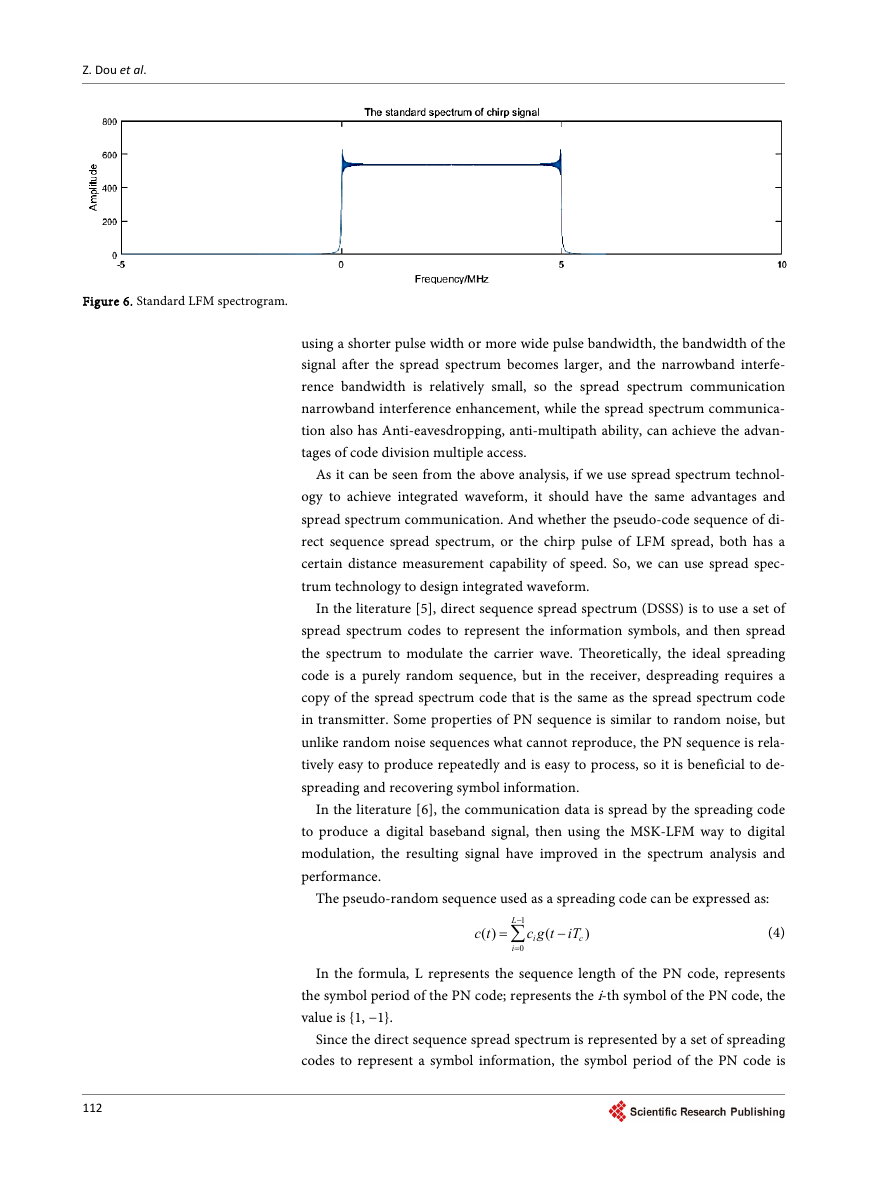
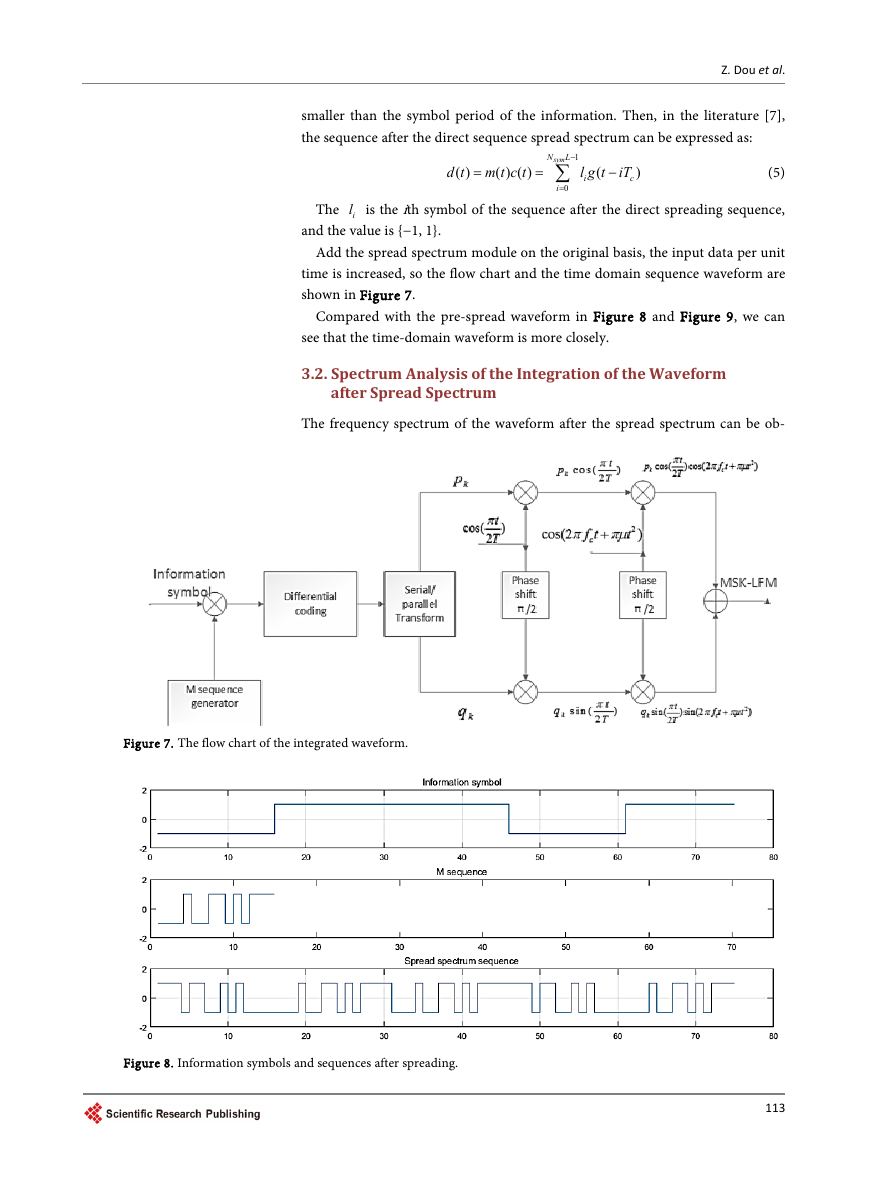
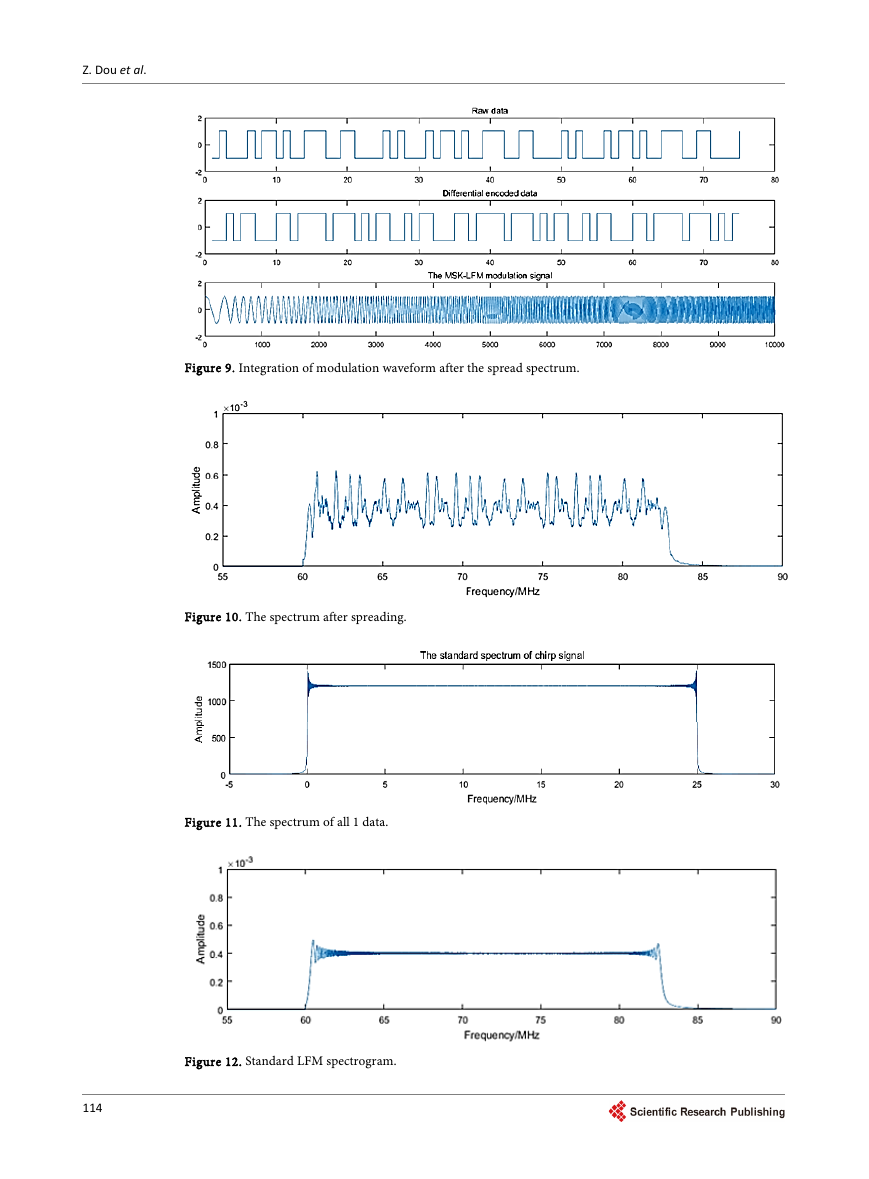
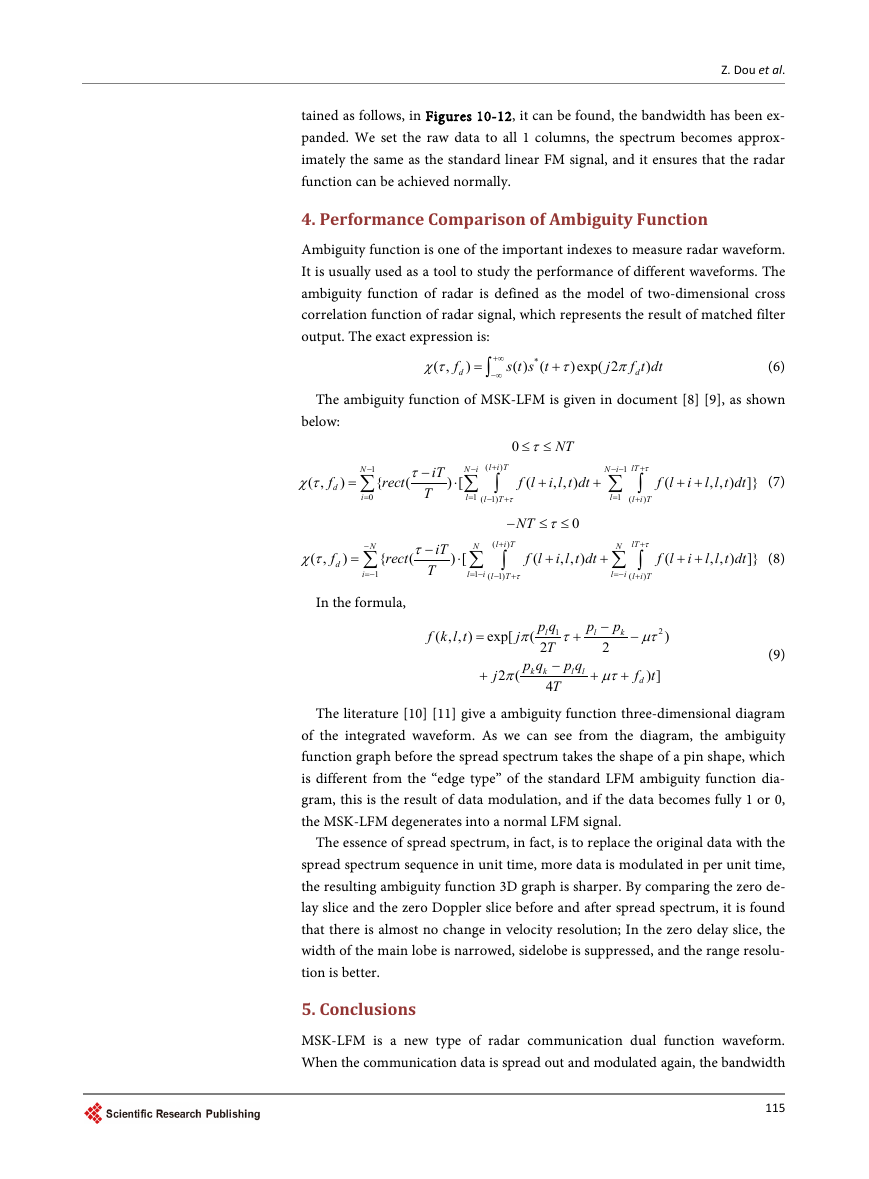








 2023年江西萍乡中考道德与法治真题及答案.doc
2023年江西萍乡中考道德与法治真题及答案.doc 2012年重庆南川中考生物真题及答案.doc
2012年重庆南川中考生物真题及答案.doc 2013年江西师范大学地理学综合及文艺理论基础考研真题.doc
2013年江西师范大学地理学综合及文艺理论基础考研真题.doc 2020年四川甘孜小升初语文真题及答案I卷.doc
2020年四川甘孜小升初语文真题及答案I卷.doc 2020年注册岩土工程师专业基础考试真题及答案.doc
2020年注册岩土工程师专业基础考试真题及答案.doc 2023-2024学年福建省厦门市九年级上学期数学月考试题及答案.doc
2023-2024学年福建省厦门市九年级上学期数学月考试题及答案.doc 2021-2022学年辽宁省沈阳市大东区九年级上学期语文期末试题及答案.doc
2021-2022学年辽宁省沈阳市大东区九年级上学期语文期末试题及答案.doc 2022-2023学年北京东城区初三第一学期物理期末试卷及答案.doc
2022-2023学年北京东城区初三第一学期物理期末试卷及答案.doc 2018上半年江西教师资格初中地理学科知识与教学能力真题及答案.doc
2018上半年江西教师资格初中地理学科知识与教学能力真题及答案.doc 2012年河北国家公务员申论考试真题及答案-省级.doc
2012年河北国家公务员申论考试真题及答案-省级.doc 2020-2021学年江苏省扬州市江都区邵樊片九年级上学期数学第一次质量检测试题及答案.doc
2020-2021学年江苏省扬州市江都区邵樊片九年级上学期数学第一次质量检测试题及答案.doc 2022下半年黑龙江教师资格证中学综合素质真题及答案.doc
2022下半年黑龙江教师资格证中学综合素质真题及答案.doc